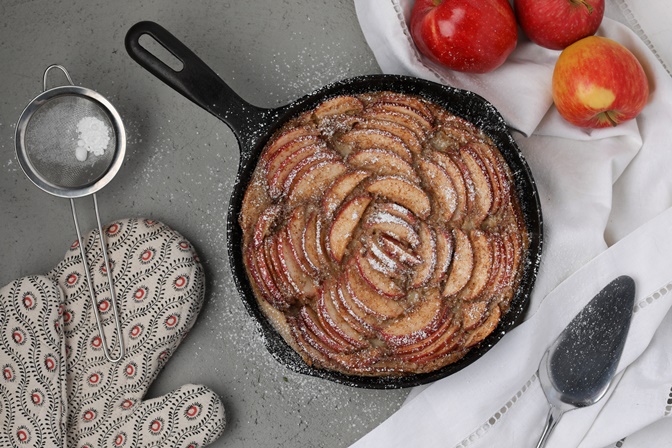3 Better-for-You Holiday Baking Hacks (Plus Recipe!)

We all have favourite holiday baked treats, from cakes and cookies to tarts and truffles. This season, enjoy your tried-and-true decadent desserts – maybe with a healthy-ish twist. I’ll share a tip for reducing sugar in recipes, but in my books, better-for-you baking is more about adding nourishing ingredients like fruit, veggies, nuts, whole grains, and healthy fats than taking away the less healthy ones.
1. Bake with apples.
Apples are always one of the best healthy buys at the grocery store, and local apples are available almost year-round. One medium apple contains four grams of fibre: soluble fibre that helps to control blood sugar and blood cholesterol, and insoluble fibre that helps with digestion. Look for recipes that include the apple peel – two-thirds of an apple’s fibre and most of its antioxidants are in the peel.
Try apples in crisps, cobblers, dumplings, cookies, muffins, and bars. Baked apples are also a favourite this time of year.
TIP: Some apples are better for baking than others. Share this handy apple usage guide with your clients.
2. Don’t cut out the yolks.
Eggs are the workhorse of the kitchen. In baking, they add flavour, structure, and moisture to cake and cookie batters, as well as richness to sauces and puddings. And, of course, you can’t make an airy meringue without them.
The nutritional goodness of eggs comes from the entire egg – half the protein and pretty much all of the vitamins and minerals are in the yolk. Some recipes only need the yolks (think creamy sauces) or only the whites (think pavlovas). But I’ve seen recipes that traditionally include whole eggs (like muffins and quick breads) modified to leave out the yolks. Yes, the baked goods will have a wee bit less fat, and the recipes will likely work, but the question is, why cut out the yolks? They’re the most nutritious part of the egg!
TIP: Some recipes call for eggs at room temperature (they yield fluffier baked goods). To quickly warm up cold eggs, put them in a bowl of warm tap water and cover the bowl with a plate. Bonus tip: Unless the recipe calls for small or medium eggs, use large eggs for baking.
3. Add a boost of healthy fats.
For extra healthy fats, fibre, protein and antioxidants, try adding finely chopped nuts or seeds (walnuts, almonds, pecans, sunflower seeds, flaxseeds, sesame seeds) to fruit crisp toppings or in muffins and quick breads, granola and granola bars.
TIP: Toasting nuts brings out the deep, nutty flavours and is well worth the time. Oven-roasting is preferred over using a skillet because the heat is more even than the stove which can result in scorched nuts with a bitter taste. Be sure to spread nuts in an even layer on a sheet pan and give them a good shake half way through for even browning. Set the oven to 350 degrees and check them at about the six minute mark. They will hold their best flavour for two to three days.
And finally, tips for reducing sugar in baked goods. For many recipes, such as cakes, no-bake bars and quick breads, you can decrease the amount of sugar by up to one-quarter. If a recipe includes vanilla or another flavour enhancer like lemon extract or almond extract, add an extra half-teaspoon of the extract to heighten the sense of sweetness. And here’s my top “Wow, I didn’t know you could do that!” tip: if a recipe calls for one cup of sugar, use three-quarters of a cup of sugar and a quarter-cup of powdered milk.
Whether you choose to tweak your baking recipes or not, enjoy all the foods you eat this holiday season!

RECIPE: Perfect for novice bakers and folks who love simple-to-prepare desserts, this Apple Clafoutis is made by layering thin apple slices over an easy-to-make batter and baking it in the oven.

